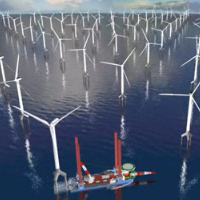Morro Bay Wants to Be First West Coast City to Grace Its Shores with a Wind Farm
 Wind farm in the North Sea near the German island of Borkum
Wind farm in the North Sea near the German island of Borkum
Morro Bay has become the first city along the California coast to put its finger in the wind to test the viability―economical, environmental and political―of offshore energy-generating wind farms.
The city signed a memorandum of understanding last month with Trident Winds LLC to explore a “long-term commercial relationship” to construct an offshore wind project. There are currently no functioning offshore wind farms in the United States, and a limited number, though growing, internationally.
President Obama’s Climate Action Plan calls for 20,000 megawatts of renewable energy to be produced on public lands and federal waters by 2020, and California has established ambitious goals for replacing fossil fuels with renewable energy.
Solar panels, are already on buildings and strewn across desert expanses, and wind farms have been generating energy on land for years. The largest geothermal field in the world, The Geysers in California, has been active since 1960. California’s vaunted hydroelectric capacity has been shrunk by the drought.
Offshore wind projects have huge potential, albeit with huge drawbacks. They are expensive, tough to construct, vulnerable, unsightly, hard on the ocean environment and a danger to birds. Despite being a tad cleaner than fossil fuels, they have elicited deeply divided responses from environmentalists.
“It sounds really, really horrible,” Susan Jordan, director of the California Coastal Protection Network in Santa Barbara, told the San Jose Mercury News. “This is a fairly massive project. . . . People don't want to look out and see a floating industrial facility.”
On the other hand, the Natural Resources Defense Council, the Union of Concerned Scientists and Greenpeace supported a controversial effort to build a wind farm off the Massachusetts coast at Cape Cod that may now be dead, while the Sierra Club backed a project in Rhode Island that began installing turbines in the summer.
There are more than 3,000 turbines on 80-plus wind farm locations in the world, providing enough electricity for 7 million people on a planet with 7 billion inhabitants. Trident Winds wants to put 100 turbines 15 to 50 miles off the Morro Bay coast, spaced about half a mile apart, covering 40,000 acres.
The turbines would float on platforms chained to anchors on the ocean’s floor, but would not be sitting on permanent concrete pylons like most of the world’s offshore farms. They would loom up to 636 feet above the surface.
A grid of electric cables could connect the turbines to the Morro Bay Power Plant, a former Pacific Gas & Electric facility that was mothballed in 2013, but still has transmission lines. The farm would generate 1,000 megawatts of electricity, enough to power up to 300,000 homes.
But that won’t happen anytime soon, if ever. The permit process will take years and lawsuits are certain to slow the process. The city of Morrow Bay is heavily motivated to push the project forward.
The former power plant, which is a big attraction for Trident Wind, is presently considered by the city to be a “visual and economic detriment” to “future growth and prosperity.”
–Ken Broder
To Learn More:
California's First Offshore Wind Farm Proposed near Hearst Castle (by Paul Rogers, San Jose Mercury News)
How a Wind-Energy Project Proposed Off Morro Bay's Coast Would Work (by Stephanie Finucane. San Luis Obispo Tribune)
Wind Proposal Whips Up Controversy (by Amanda Onion, ABC News)
The U.S. Dips a Toe in the Offshore Windfarm Water (by Aaron Heinrich, Gizmag)
Offshore Wind Energy (Bureau of Ocean Energy Management)
- Top Stories
- Controversies
- Where is the Money Going?
- California and the Nation
- Appointments and Resignations
- Unusual News
- Latest News
- California Forbids U.S. Immigration Agents from Pretending to be Police
- California Lawmakers Urged to Strip “Self-Dealing” Tax Board of Its Duties
- Big Oil’s Grip on California
- Santa Cruz Police See Homeland Security Betrayal in Use of Gang Roundup as Cover for Immigration Raid
- Oil Companies Face Deadline to Stop Polluting California Groundwater





